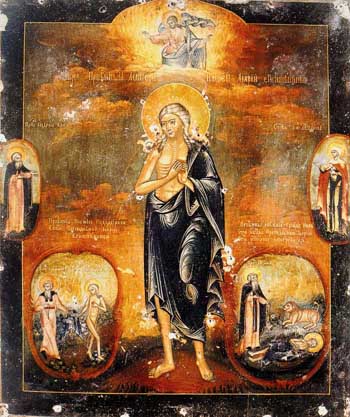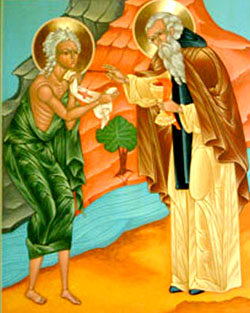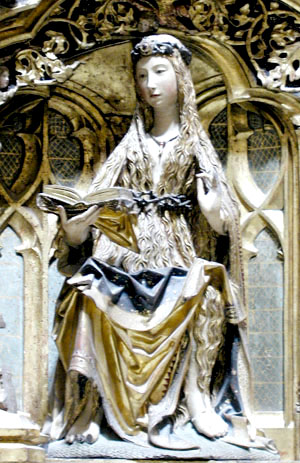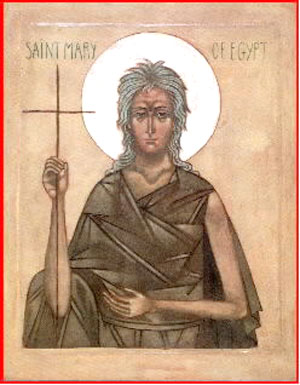 |
The Saint of the Day
St. Mary of Egypt – April 2
Prof. Plinio Corrêa de Oliveira
Biographical selection:
St. Mary of Egypt, also called the sinner, lived 47 years in the desert making penance and suffering privations. Toward the end of her life, St. Zosimus of Palestine came upon her in the desert. When the Abbot asked her who she was and from where she came, this strange woman - burned and darkened by the sun - answered:

St. Mary of Egypt and scenes from her life
|
“Father, forgive me, but when I start to tell you my story you will run from me, as from a snake, for your ears will not be able to bear the vileness of my actions and the air will be contaminated by my impurity.
"I am called Mary and I was born in Egypt. I went to Alexandria at age 12 and lived there 17 years as a public woman, giving myself to whoever wanted me. But one day, I learned that some inhabitants of this city were going on a pilgrimage to Jerusalem to adore the True Cross, and I asked the sailors to let me also go aboard. They asked for money to pay for the journey, and I answered that I had none, but I offered my body instead. So the voyage was made.
“In Jerusalem, when I went with the other pilgrims to the church on the holy day of the Exaltation of the Cross, I felt an irresistible force that prevented me from crossing the doorstep. Three or four times I approached the doors of the church, and each time that invisible power prevented me from entering. All the others went in freely without any obstacle.
“Retreating to a corner of the porch, I began to understand the reason why I was prevented from being admitted to see the life-giving Cross. The word of salvation gently touched the eyes of my heart and revealed to me that it was my impure life that barred the entrance to me. I began to weep and lament, and beat my breast and sigh from the depths of my heart. And so I stood weeping when I saw above me the icon of the Most Holy Mother of God.
“Turning to her my bodily and spiritual eyes, I begged her to obtain forgiveness for my sins and to order the entrance of the church to be opened to me so that I could adore the True Cross. In exchange, I promised to renounce the world and live in chastity.
“With this prayer, I acquired some hope and felt some confidence in the mercy of the Mother of God, and went again to enter the church. This time I was able to go in without any difficulty and found myself in the holy place. As I piously adored the Holy Cross, I heard a voice that said, “If you cross the Jordan, you will find glorious rest.”
“With these words, I left the church and set off on my journey. As I was leaving the church a stranger glanced at me and gave me three coins. Taking the money, I bought three loaves and took them with me on my journey.
“I crossed the River Jordan and came to the desert, where I have lived for 47 years, never seeing a single human face during this whole time, feeding myself from those three loaves of bread that I brought with me. My dresses were reduced to tatters long ago.
“During the first 17 years I was tormented by temptations. After that, by the grace of God, I completely conquered them. This is my history. I am telling it so that you might pray to the Lord for me who am such a sinner.”
Then the old man, prostrating himself on the ground, praised God in the person of His servant.
She told him: “Now I ask you this. On sunset of the holy day of the Last Supper, bring me the Body of Christ. Wait for me on the banks of the Jordan, so that I can come and partake of the life-giving Gift. For during all the time I have been here, I have not approached the Holy Mysteries.”

St. Zosimus gives Communion
to St. Mary of Egypt
|
The old man returned to his monastery, and the next year he returned to the banks of the Jordan bringing a consecrated Host. After waiting a while, he saw the holy woman appear and stand on the other side of the river, and he wondered how he could approach her since there was no boat. Then he saw that she made the Sign of the Cross over the waters and she at once stepped onto them and began walking across the surface until she reached him.
In awe over the miracle, the religious man wanted to prostrate himself humbly at her feet, but she said: “My Father, do not prostrate yourself before me, for you are a priest carrying the Body of Christ.”
After receiving the Holy Eucharist, she asked him the favor to return one more time to the same place where she first met him.
The next year Zozimus crossed the river and went to the place where he first met her. He found her lying dead in the sand. He wept with sorrow but did not dare to touch her remains, fearing to offend her since she was wearing nothing.
As he was wondering whether to bury her, he read an inscription in the sand by her head: ‘Abbot Zosimus, bury the body of humble Mary on this spot. Return to dust that which is dust and pray the Lord for me, who departed on
April 2, on the very night of Our Lord’s Passion, after having partaken of the Divine Mysteries.” [St. Mary died in the year 522].
Then Zosimus thought, “It is time to do as she wished. But I am old and weak, and how am I to dig a grave with nothing but my hands?”
Then he saw a lion, which drew near and with its front paws it dug a hole deep enough to bury the body. After the body was buried, the lion went off into the depth of the desert like a lamb, while Zosimus returned to the monastery glorifying and blessing Christ Our Lord.
And on reaching the monastery he told all the brothers about everything, and all marveled on hearing of God's miracles. And with fear and love they kept the memory of the Saint.
(From The Life St. Mary of Egypt by St. Sophronius, Patriarch of Jerusalem, 7th century).
Comments of Prof. Plinio:
You should consider the beauty of the relation established here between sin and penance. The sinner was a very bad woman. For 17 years she had lived the worst possible life. Then this woman, directed by the unpredictable ways of Providence, arrived at the moment of her conversion.
To be present at the feast of the Exaltation of the Holy Cross in Jerusalem, she asked the sailors to include her on the voyage. But she made the worst kind of exchange for her passage: she offered her body to pay the way.
In Jerusalem, she went with the pilgrims to the Church of the Holy Cross. It was there that she experienced the clash between two realities. On one hand, she clearly saw her public scandalous sin in all its ugliness. On the other hand, she became aware that the Triune God, Who in His infinite purity, has horror of this sin and does not want the sinner to stain His sanctuary. For this reason, an invisible force prevented her from entering the church.

The contrition of St. Mary of Egypt was motivated by love of God - Cathedral of Burgos, Spain
|
There is also, however, the grace and the mercy of God. She retreated to the outdoor porch, and in solitude she began to repent. She saw the horridness of her crime. She realized the enormous consequences of her sinful life, and how it was just that the wrath of Heaven should prevent her from entering the sanctuary. The doors of the church that were open to everyone were closed to her because of her vile life.
On the wall of the porch there was, providentially, an icon of Our Lady. She met, then, the Mother of Mercy, the Gate of Heaven. She prayed to the right person in order to receive mercy. Our Lady offered that mercy and because Mary of Egypt accepted, she was invited to make an extraordinary penance. She fled human relations completely. For an extraordinary sin, there was an extraordinary penance.
She crossed the Jordan River and retired to the desert where she spent 47 years making penance and seeing no other person. The beauty of the famed sinner disappeared; her skin became burned and dark; her dresses shredded into tatters. In that solitude she was turned toward loving God.
In the first phase she had temptations, but then they ended. Her penance became the penance of the innocent and no longer of the penitent. She acquired a high level of virtue and was completely forgiven for the sins of her past. After that, she made penance not only for herself, but for all sinners. Before her death, God wanted her to receive His supreme proof of reconciliation, Holy Communion.
Then a saintly old monk of the desert appeared – a holy priest of those times, with a long white beard, a black habit with a long hood, and a long stick. He was walking alone in the desert, blessing animals, condemning tyrants, accusing criminals, praying and working miracles for the sick. The only man I know in modern times similar to those old fathers of the desert is Blessed Charbel Macluf, who embodied all the primitive and magnificent charm of the epoch of the desert fathers.
So, this holy Abbot in the desert came upon this creature, and asked who she was. She answered with sententious words proper to the epoch: “Father, forgive me, but when I start to tell you my story you will run from me, as from a snake, for your ears will not be able to bear the vileness of my actions and the air will be contaminated by my impurity. I am called Mary and I was born in Egypt.” This introduction has a great literary beauty and reflects the extraordinary valor of her soul.
Her love of God was so elevated that when she went to receive Communion a
year later she walked over the water. This signifies that God had forgiven everything, had forgotten everything; God had become only love for her and she survived solely on divine grace. A day after she received Holy Communion, she died. The holy man returned a year later to the place in the desert where he had first met her and found her body there. She had left a last will written in the sand asking him to bury her there.

St. Mary of the Desert
|
The pure Abbot had some hesitancy about burying her because she was not dressed. Further, he did not know how he was going to dig a deep enough hole to bury her with his mere hands. But for the funeral of this woman penitent who had glorified the desert, God sent the king of the desert, a lion. It is a very poetic scene to imagine the lion digging the hole while the old man looked on. He blessed her, buried her, and it was finished. It continues only as the history of St. Mary of the Desert, which is a golden page in the History of the Church. It is a marvel to have this description of the life of such a great soul.
You can see the beauty of contrition. Our epoch does not have an accurate notion of what contrition is. The modern mentality spreads the idea that contrition is exclusively fear of God, and that fear of God expunges the love of God. With this, it considers contrition as being, in a certain way, the opposite of the love of God. Nothing is further from the truth. Why?
First, because fear of God as a virtue is a gift of the Holy Ghost that cannot obliterate the love of God. Real fear of God is a means to increase the love of God and union with Him. We can see this in the repentance of St. Mary of the Desert, which led her to an apex of love.
Second, because contrition is not motivated principally by fear, but rather by love. What is motivated by fear is attrition. Contrition is motivated by love. One can go through his whole life growing in contrition as well as love of Our Lord and intimacy with Him. This was what St. Peter did until he died. These things are intertwined.
Therefore, the life of St. Mary of the Desert should not cause us terror, but rather admiration for that primitive figure of a great penitent. The Catholic Church is like a sunlit day with different colors for its different hours. Each epoch has its own color. What shines in the life of St. Mary of the Desert is the primitive life of the Church – great sins, great penances, great mortifications, virginal innocence, and tremendous austerities. Her life is like the tolling of an old, weighty bell that sounds from the past. This light and resonance from the past should enthuse the souls who truly love Our Lady.
Let us ask St. Mary of the Desert to give us real contrition for our sins, a contrition accompanied by peace, a contrition that brings our souls closer to Our Lady.


  | | Prof. Plinio Corrêa de Oliveira | |
The Saint of the Day features highlights from the lives of saints based on comments made by the late Prof. Plinio Corrêa de Oliveira. Following the example of St. John Bosco who used to make similar talks for the boys of his College, each evening it was Prof. Plinio’s custom to make a short commentary on the lives of the next day’s saint in a meeting for youth in order to encourage them in the practice of virtue and love for the Catholic Church. TIA thought that its readers could profit from these valuable commentaries.
The texts of both the biographical data and the comments come from personal notes taken by Atila S. Guimarães from 1964 to 1995. Given the fact that the source is a personal notebook, it is possible that at times the biographic notes transcribed here will not rigorously follow the original text read by Prof. Plinio. The commentaries have also been adapted and translated for TIA’s site.
|
Saint of the Day | Home | Books | CDs | Search | Contact Us | Donate

© 2002- Tradition in Action, Inc. All Rights Reserved
|
 |

|